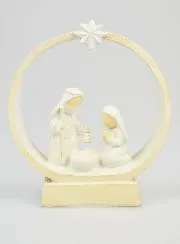The Nativity, the representation of the birth of Jesus Christ, is one of the most iconic and universal subjects in the history of art. Since the first centuries of Christianity, this theme has inspired generations of artists, giving rise to a variety of styles, symbolisms and techniques reflecting the cultural, religious and political contexts of each era. This article invites you to discover how the Nativity has been interpreted artistically throughout the ages, from the earliest Christian frescoes to contemporary works.
The Nativity in early Christian art (3rd-6th century)
The first representations of the Nativity appear in the catacombs of Rome, notably in those of Priscilla and Saint Sebastian. These works, often frescoes or reliefs, are characterised by their simplicity and symbolism.
Discreet symbolism: The first images of the Nativity are often allegorical. The cot and star are sometimes suggested symbolically rather than figuratively.
Pagan influence:Representations of Jesus as an infant in a manger are sometimes inspired by Greco-Roman artistic traditions, where the gods are depicted as children.
Importance of Mary: From this period onwards, the figure of Mary begins to occupy a central place, testifying to the rise in power of her cult.
The Byzantine Golden Age (6th-15th centuries)
Byzantine art marks an important stage in the representation of the Nativity. Artists of this period created icons rich in theological symbolism and narrative detail.
The format of the icon: Byzantine representations of the Nativity are often made on gilded wooden panels, designed to be venerated in churches or monasteries.
Spatial organisation: Byzantine composition is hierarchical. Jesus is often depicted in a dark grotto (symbolising the shadow of death) with Mary in a central position. Shepherds, angels and the Magi surround the scene.
Theological symbols: Elements such as the ox and the donkey appear regularly, symbolising divine recognition of creation. The Star of Bethlehem is often depicted as divine light piercing the darkness.
The Western Middle Ages (11th-15th centuries)
The Western Middle Ages saw a more narrative and emotional development of the Nativity, particularly through the influence of Gothic art.
Enlightened manuscripts : Liturgical books such as the Gospels or Books of Hours contain beautifully detailed miniatures of the Nativity, often accompanied by scenes from the Adoration of the Magi or the Annunciation to the Shepherds.
Sculptures: Nativity scenes appear on the tympanums of Gothic churches and altarpieces, inviting the faithful to meditate on the mystery of the Incarnation.
The humanity of the scene: With Gothic art, the emphasis is on emotion and tenderness. Mary is often depicted as a loving mother, gently holding Jesus.
The Renaissance (15th-16th century)
The Renaissance marks a turning point in the way the Nativity is depicted. Artists of this period adopted new techniques and were inspired by humanist ideals.
Perspective and realism: Artists such as Giotto, Botticelli, and Leonardo da Vinci incorporated linear perspective to give depth to their works. Characters gained in realism and individuality.
Naturalistic detail: The Renaissance rediscovered nature. Settings became more elaborate, with precise landscapes and architectural elements. For example, in Botticelli's Mystical Nativity, the scene is surrounded by a teeming natural environment.
Private commissions: During this period, the Nativity became a frequent subject of altarpieces commissioned by wealthy patrons for family chapels.
The Baroque and Rococo (17th-18th centuries)
The Baroque and Rococo transformed the Nativity into a dramatic scene, full of movement and emotion.
The play of light: Baroque artists such as Caravaggio use marked contrasts between light and darkness (chiaroscuro) to emphasise the divine character of the Christ Child.
Theatricality: Baroque compositions are dynamic and dramatic, emphasising the emotional intensity of the scene. Angels swirl above the cot, and the figures seem animated by a palpable fervour.
The richness of the decorations: Under the influence of Rococo, representations of the Nativity become more opulent, with gilded ornaments and pastel colours.
The modern era (19th-20th century)
With the emergence of modern art, representations of the Nativity take on varied and sometimes abstract forms.
The return to simplicity:
Some artists, such as the modern Primitives, were inspired by naïve or popular styles to depict the Nativity with simplicity and sincerity.
Social perspectives: In the 20th century, some artists used the Nativity to denounce inequality or human suffering, placing the scene in contemporary contexts.
Artistic experimentation: Painters such as Marc Chagall and Salvador Dalí reinterpreted the Nativity through the prism of surrealism, highlighting a dreamlike and personal vision of the event.
Contemporary representations (21st century)
Today, representations of the Nativity continue to evolve, reflecting the cultural and spiritual diversity of our time.
Digital art: Digital artists create modern representations of the Nativity, often shared on social networks to reach a global audience.
Art installations: In exhibitions and public spaces, interactive or conceptual installations offer new and engaging visions of the Nativity.
Interfaith dialogue: In a globalised world, some contemporary works incorporate elements from different religious traditions to promote dialogue and unity.
A timeless source of inspiration
Across the centuries, artistic representations of the Nativity bear witness not only to the evolution of styles and techniques, but also to the spiritual and social concerns of each era. Whether through the simplicity of early Christian frescoes, the grandeur of Baroque altarpieces or modern interpretations, the Nativity remains an inexhaustible source of inspiration for artists. By revisiting these works, we are invited to contemplate, in our turn, the mystery and beauty of this founding moment of Christianity.




















